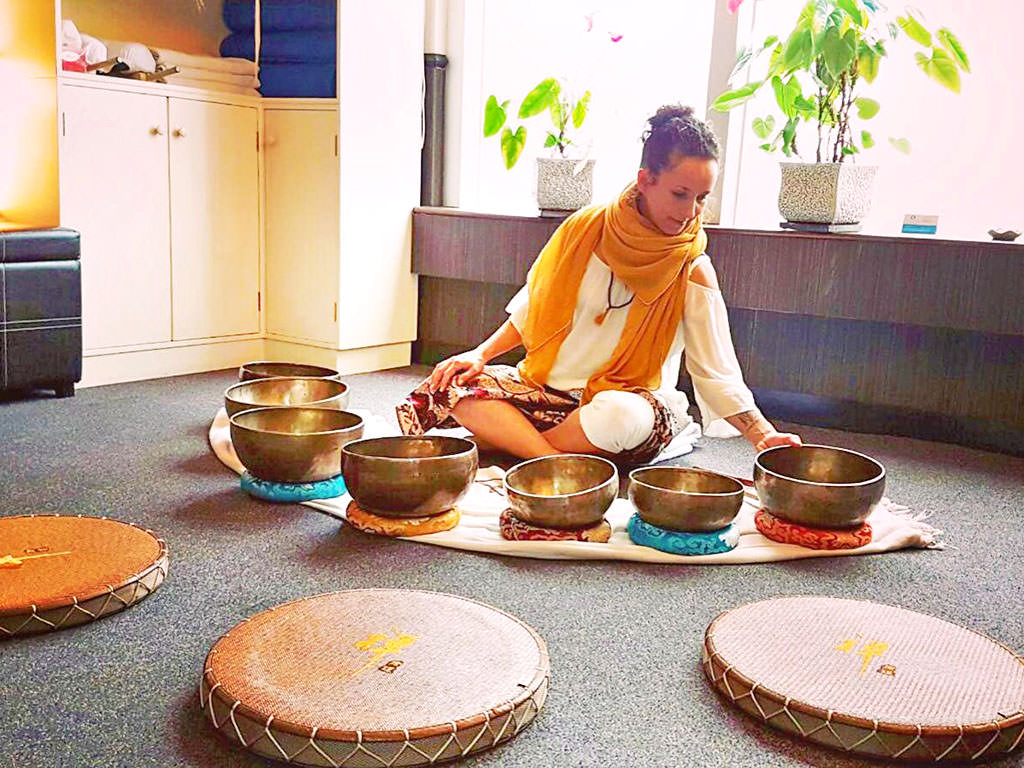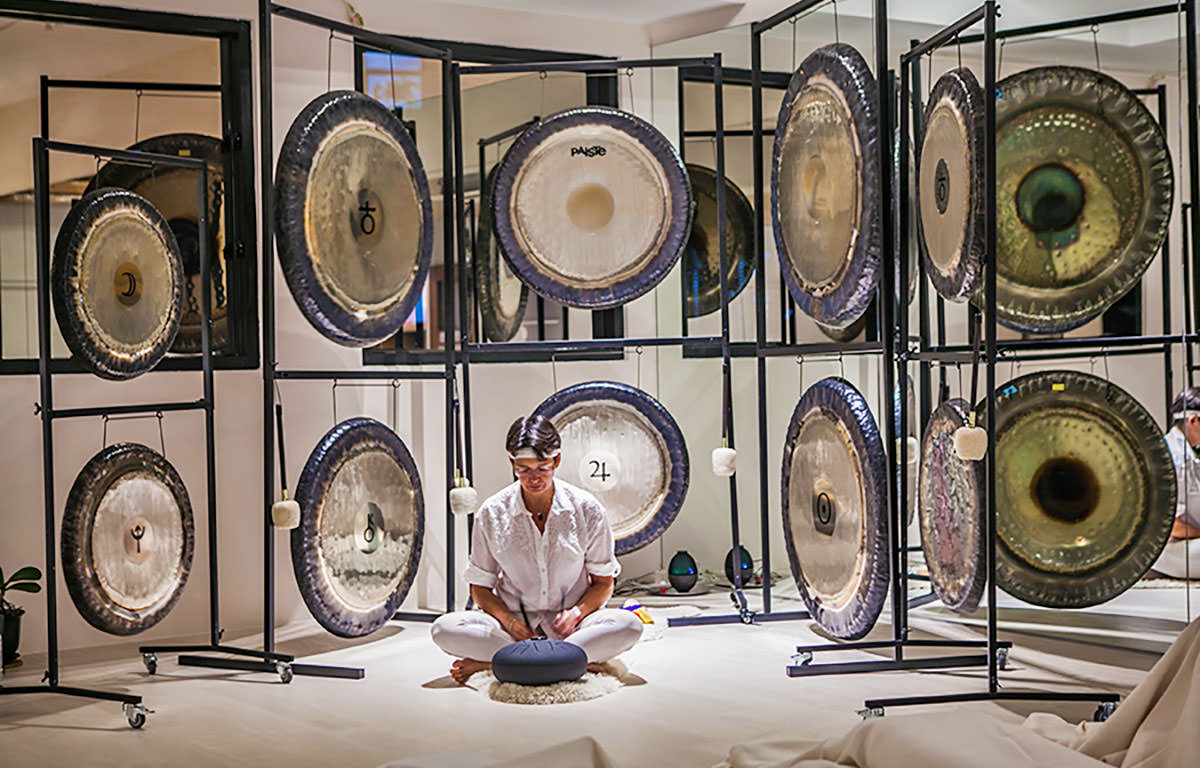5 Mins Read
Music is one of the most compelling and basic forms of human expression. It has the power to get inside our body and inspire us, alter our moods and even change our state of mind. When the right track hits, the sound of the beat helps us to forget ourselves, our problems, and the commotion of life. As one of the most transformational and therapeutic sounds in existence, gongs are linked to health as part of a holistic cleansing process for the subconscious mind. Sometimes it’s called a gong bath, where participants are bathed in sound waves, washing away tension and providing an energetic cleanse through the vibrations of the gong. In an effort to keep you in the loop on all things #wellness, we’re here to explain what exactly is a gong bath, and where to find one in Hong Kong.
What Is A Gong Bath?
A traditional healing practice, a gong bath uses the vibrations of sound and frequency emitted from a gong, a cylindrically-shaped hanging percussion instrument that originated in South East Asia, to help reduce anxiety, stress and release repressed emotions. The idea is that the sound reflecting from the gong will infiltrate your outer consciousness and penetrate your core, disconnecting you from the superficial world and all the troubles associated with it. Unlike therapy, which requires talking about your problems, a gong bath offers the opposite experience. It uses no words and is effortless. It is particularly helpful for those who find forming and articulating words difficult. Your body surrenders to sound, helping to clear any blockage (which may help you find the words you’re looking for).
How Does It Work?
A gong bath setting consists of yoga mats, blankets, eye masks and pillows made available to participants in an open space. Some studios will host a light yoga session or take you though a few simple physical exercises to warm your body and get you in the right frame of mind. When the sound meditation begins, the vibrations of the gong evokes a deep, rich, intricate web of reverberations that quiets the mind, allowing a profound relaxation to take place- a state during which self-healing is more likely to occur. Two main types of gongs are used: suspended or resting. Depending on the gong healer, some will work with one instrument or several. Tibetan Singing Bowls (a resting gong) which have been used for centuries in healing and meditation, produce a sound similar to a bell when struck with a mallet. The bowls are “sung” when the mallet is consistently in contact with the edges of the bowl. Planet gongs are suspended and tuned to specific frequencies of a planet or celestial body. The calculations for the frequency are based off the work of Hans Cousto, a renowned Swiss mathematician and musicologist. The pulsation and harmonic overtones is said to be soothing to listeners. The third and most familiar gong used in meditation are symphonic gongs. The gong of choice for most Kundalini yoga (which focuses on purification of the subconscious) practitioners and sound therapists, symphonic gongs have a clear fundamental tone with rich overtones, effective for sound healing.
Different rhythms and types of mallets used will create different effects. When the sound emitting from the gong(s) becomes intense, louder or the pace quickens, the pressure liberates the nervous system of fears or emotional impediment. This force is the release most participants experience. The sound resonates with the mind body connection, allowing an internal dialogue from within. A typical meditation will last between 45 minutes to an hour. Afterwards, it’s common for refreshments of tea and chocolate or brownies to be served. Chocolate help to release endorphins, inducing a more relaxed and happier state of mind.
Is There Any Scientific Evidence Around It?
While there is limited scientific research on sound baths and sound healing overall, more and more studies are shedding light on the effects of music and the brain. Research has found sound therapy to relieve chronic pain, high blood pressure, and insomnia. After being introduced to singing bowls by a Tibetan monk patient, Dr. Mitchell Gaynor, a former New York oncologist, began using sound therapies to help his cancer patients and became a gong devotee. He penned six books, including The Healing Power of Sound (1999) before his death in 2015 and is considered an authority on the subject.
Why Is It Good For Me?
Sound therapy has been known to improve symptoms associated with stress, migraines, depression and lack of concentration and focus. Many meditation centers that offer gong baths also speak of added benefits like mental clarity, better sleep, and increased energy. In our hyperactive city, it’s important to have a release from the hustle, the constant distractions and take time out for yourself. If staying silent during meditation or going for a sweat session isn’t your thing, a gong bath might be. The effects of a session can last through the night and over several days. The most common response people experience from a gong bath is an overall state of relaxation.
Where To Find A Gong Bath In Hong Kong?
As always, Hong Kong has the goods on the wellness front. There’s a
- Balance Health offers Tibetan Singing Bowls Meditation every Friday at noon. Click here for more information. 27/F, Universal Trade Centre, 3 – 5 Arbuthnot Road, Central, +852 2530 3315.
- Red Doors offers Gong Baths. Click here for their schedule. 21/F, Flat A, Lee Fund Centre, 31 Wong Chuk Hang Road, Wong Chuk Hang, +852 2110 0152.
- Sound Therapy offers Gong Baths. Click here for more information. 10/F, 4-6 Morrison Hill Road, EIB Tower, Wan Chai, +852 9729 4367.
- Lift Wellness Group offers crystal singing bowls for sale.
Photos courtesy of Balance Health (lead), Red Doors and Sound Therapy






